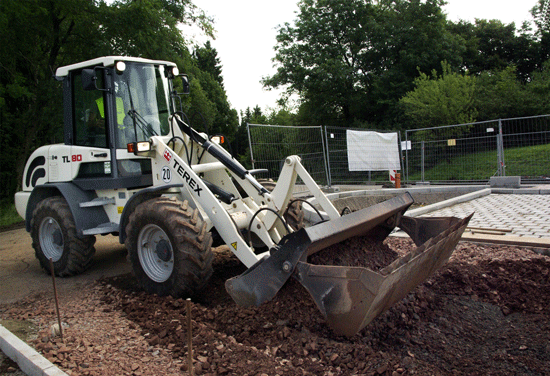Compact Wheel Loader Industry Inventory: Terex
 NOTE: This is the third of many blogs detailing an industry-wide summary of compact wheel loaders. Be sure to check back throughout August for the entire listing.
NOTE: This is the third of many blogs detailing an industry-wide summary of compact wheel loaders. Be sure to check back throughout August for the entire listing.
Terex compact wheel loaders offer economical, quiet and low-maintenance operation without sacrificing cutting-edge technology. Ideal for digging, loading and hauling jobsite materials, the progressive Terex range addresses the needs for a variety of construction site work, nursery and landscape applications.
Each model incorporates transverse-mounted engines for optimal stability — so Terex wheel loaders can lift and transport high payloads, and in turn lower fuel consumption. Designed with an oscillating rear axle, it provides comfort and easy handling on rough terrain by maintaining four-wheel traction, as well as articulated steering to effortlessly maneuver in tight spaces.
Operators can easily and accurately control movements even when giving the loader full power — making Terex hydrostatic wheel loaders the choice for powerful breakout and fast lifting.
Terex compact wheel loaders range from 50 to 175 hp with bucket capacities between 0.65 cu yd and 6 cu yd and achieve breakout forces from 8,325 to 26,995 lbs.
Terex compact wheel loaders come standard with a general purpose bucket. Terex also offers the following optional attachments for its compact wheel loader line: side-dump bucket, light material bucket, forks and carrier, brooms, multi-purpose bucket and crane jib.
Other features on Terex compact wheel loaders include:
• Articulated, full hydraulic steering for fast and low effort steering for increased stability while operating even at low engine speeds.
• A universal coupler system to make the wheel loader compatible with all skid-steer attachments, as well as to make it fast and easy to switch from a loader to a material handler.
• Hydrostatic, four-wheel drive with creep mode and dynamic braking to give operators speed control and efficient engine rpm when working in tight areas. The hydrostatic drive also reduces tire slippage which results in faster cycle times and less wear and tear on the tires.
• Low front windshield and right- and left-hand side windows to offer operators the best possible view of the jobsite, especially important for jobs when people are working alongside or moving around the machine.
• A large, roomy operator’s cab that provides easy access from both sides.
Advice to Buyers
When choosing a wheel loader, make sure the piece of equipment is going to be adequate for 85-90 percent of your jobsites’ needs — don’t sacrifice power, breakout force or anything else just to save a dollar. Also, always buy quality — a wheel loader needs to durable and reliable because downtime is expensive.
When considering one brand over another, consider the reliability of the machine and how well you know and understand its parts. Are you comfortable with the technology that’s under the hood? If you can handle the small maintenance issues yourself, you can help reduce overall cost and downtime. Also, how responsive and expansive is a brand’s dealer network? You should look for a distributor who is conveniently located to your jobsites and who can deliver the parts and services you need quickly.
Productivity features are also important in building a case for investment to meet on-site productivity requirements and project time constraints. ROI will be considered in the context of the hours the machine is working and revenue generated so whether a customer bites the bullet during tough economic times ultimately depends on the financial situation of the company and the anticipated level of current and future work/projects.


Comments are closed here.